Sales metrics: A comprehensive guide to boosting your business

Director of Sales Development at Dialpad

Tags
Share
In sales, there are often a huge number of different metrics and KPIs that revenue leaders need to hold their teams to.
Depending on your industry, sales cycle length, makeup of the team (whether you have full-cycle reps versus AE and SDR partners, for instance), and so on, the best sales metrics for your team will likely look a little different from those for a team of a different size in a different industry.
In this guide, I’ll walk you through some of the key sales metrics our sellers use at Dialpad, why they work well for us as a B2B SaaS sales org, and tips for how to set and hit your number more effectively.
What are sales metrics?
Sales metrics are essentially quantitative targets and measurements that are used to assess a sales team’s performance and also the success of your sales process overall.
They can range from straightforward indicators like revenue and conversion rates to more nuanced measurements, such as customer lifetime value and sales cycle length, which we’ll talk about in more detail below.
Sales metrics examples: A look at different categories
Metrics in sales come in a wide variety of types and categories, each offering unique insights into specific aspects of your sales process. Let's look at some common types of sales metrics:
3 Customer relationship metrics
While these metrics are sometimes measured by other teams too (like customer support or customer success teams), a good sales team that’s well integrated into the business should be keeping an eye on these as well.
If a sales leader knows their team has high win rates but low customer retention rates, for example, that might prompt them to look at whether their sellers are going after the right prospects who are actually a good fit for the company. And while reps may not think these metrics directly affect them, they do—these numbers are kind of metrics for sales too because they affect the health of the business and if you want to stick around and keep selling this product, you should care about them.
Customer satisfaction (CSAT)
CSAT measures customer satisfaction, usually with a specific support interaction.
Companies usually collect CSAT scores by sending customers a survey right after a support call, email, or live chat (to keep the memory fresh).
One of the biggest challenges with this, of course, is that not a lot of people actually fill out those surveys. And usually only the angriest—and happiest—customers actually bother responding, which means your CSAT feedback is likely to be very skewed and not representative of how your customers feel overall.
That’s where a tool like Dialpad's industry-first Ai CSAT feature can help, by inferring CSAT scores for 100% of customer calls thanks to its hyper-accurate transcription feature. The result: a much more representative sample size for CSAT scores, and a more accurate understanding of how satisfied customers really are:
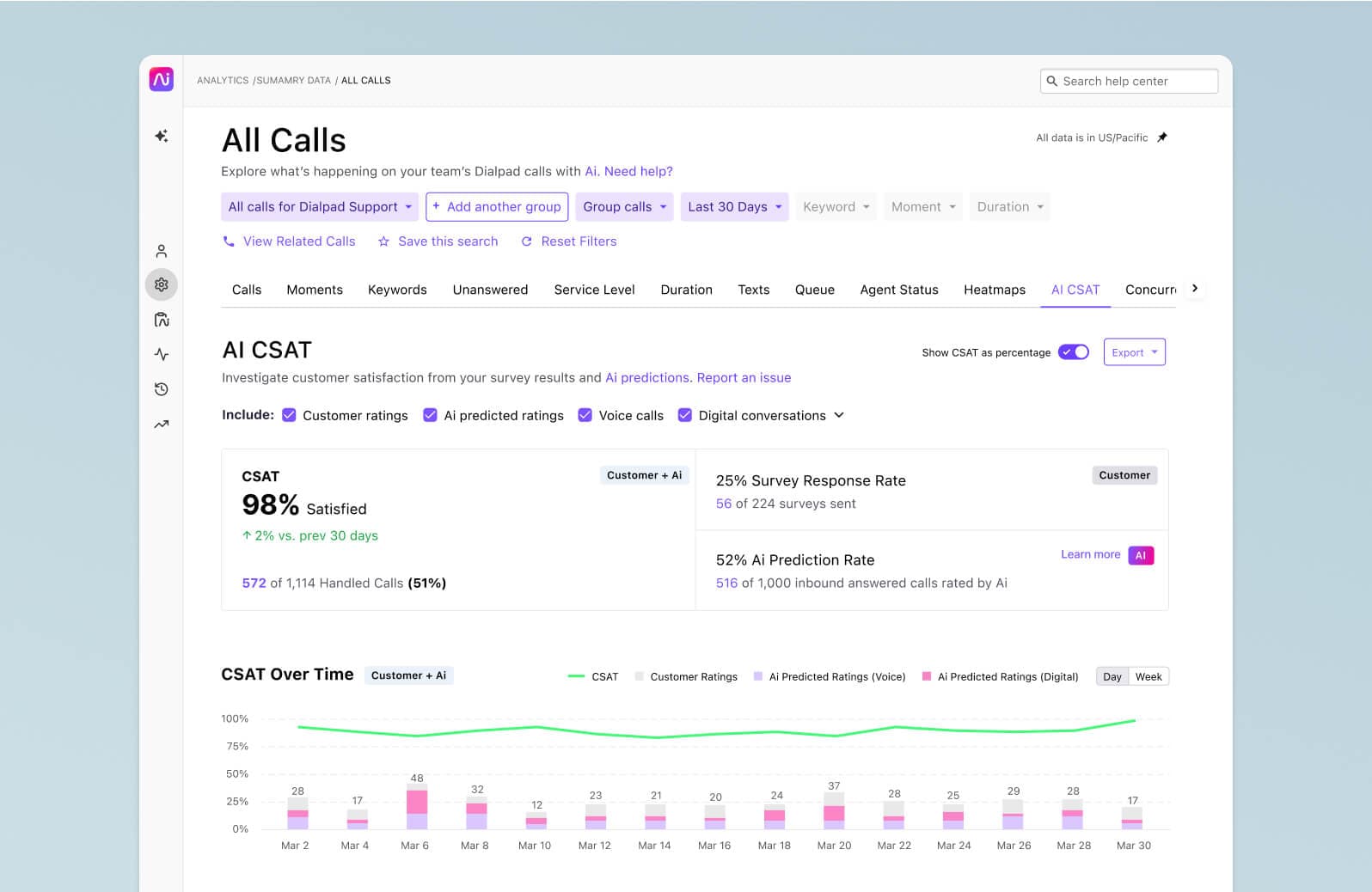
Customer retention rate
The customer retention rate measures the percentage of customers who continue to buy from your company over time. A high retention rate is a positive indicator of customer loyalty, and SaaS or subscription businesses are especially concerned about retention because you’re not just selling a one-off product like an engagement ring..
Customer lifetime value (CLV)
CLV estimates the total revenue you can expect from a customer throughout their entire relationship with your business. The higher your CLV, the better—and if it’s a bit low for your liking, it might be time to ramp up your customer retention efforts.
10 Top sales performance metrics to track
While financial metrics and customer relationship metrics are important, there is a group of metrics that sales leaders absolutely need to be aware of: sales performance metrics.
These are metrics that focus less on financials and more on evaluating the effectiveness of your sales team, and most of them are technically “sales management metrics” because they’re most relevant to managers and above. They provide insights into both individual and team performance, and help more senior leaders identify areas for improvement and recognition.
Here are 10 of the top sales performance metrics examples that can provide valuable insights into the actual effectiveness of your sales efforts:
Conversion rate
The conversion rate measures the percentage of leads that convert into paying customers. Sometimes, the term is used to refer to website conversion rates, completely devoid of salesperson interactions, but in a sales context, this refers specifically to sales reps converting prospects into customers. A higher conversion rate usually indicates a more effective sales process (or ecommerce flow on your website).
Win rate
The win rate is the percentage of deals won compared to the total number of opportunities—not quite the same as conversion rate, even though junior reps sometimes confuse these. Monitoring the win rate helps you assess the efficiency of your sales team in closing deals.
Sales velocity
Sales velocity measures how quickly deals move through the sales pipeline. If you find that your team is struggling to hit their number consistently, it may help to look at how long it takes them to close deals and where there might be bottlenecks that are slowing down deals.
Sales cycle length
The sales cycle length measures the time it takes for a lead to become a customer. Shorter sales cycles are generally better because you’re getting revenue in the door more quickly.
Customer Acquisition Cost (CAC)
CAC represents the average cost associated with acquiring a new customer. Monitoring CAC helps ensure that your customer acquisition efforts are cost-effective and sustainable for long-term profitability. (If it costs you $150 to earn a customer, but that customer only pays you $50 over their lifecycle, that’s not a good CAC.)
Sales Qualified Leads (SQL) Ratio
The SQL ratio evaluates the percentage of leads that meet the criteria for being qualified sales opportunities. A higher SQL ratio is good because it tells you that your sales team is focusing on leads with a higher likelihood of converting into paying customers.
Lead-to-Customer conversion rate
This metric calculates the percentage of leads that ultimately become paying customers. Monitoring lead-to-customer conversion rate helps assess the overall effectiveness of your lead nurturing and conversion strategies.
Sales forecast accuracy
Sales forecast accuracy measures how closely your predicted sales align with actual sales results. Forecasting accurately is one of the hardest things to do, even for seasoned revenue leaders, but it’s essential for effective resource allocation, strategic planning, and long-term company success (especially if your company has an exit like an IPO in its sights).
Revenue
Revenue is the total income generated from sales within a specific time period. (You can look at quarterly, monthly, or annual revenue, for example.)
Average deal size
Your average deal size is the average monetary value of each sale. Some sales teams measure a similar metric to this called ACV, or average contract value, which is more for subscription or service-based businesses.. Monitoring this metric helps you identify trends in customer purchasing behavior and tailor your sales strategies accordingly.
The 3 best sales force effectiveness metrics to track
To measure the effectiveness of your sales force, it helps to understand your sales activity metrics, which measure the day-to-day activities of the sales team. Tracking these metrics provides insights into productivity and they’re probably the most traditional way of tracking whether your sellers are doing any work.
There are of course other sales effectiveness metrics, but if you want to get down to brass tacks, these are the key activities to monitor.
Calls and emails
Tracking the number of calls made and emails sent by SDRs and BDRs is common across most industries, since for these reps, it’s very much a numbers game. The more at-bats you can get, the more likely you’ll book more meetings.
Dialpad even has a voicemail drop feature, which essentially lets sales reps record a voicemail message and “drop” it into a phone call when they hit a prospect’s voicemail. This way, they don’t have to spend time reciting the same message every single time:

Meetings
Of course, making a thousand calls a day doesn’t mean much if you don’t book any meetings or make any sales. So, the next step up is to track the number of meetings that sellers are booking with prospects.
One thing that is really handy is Dialpad’s integration with Google Calendar and Microsoft 365. When reps create a meeting with a prospect, it automatically populates the meeting link. It may not seem like much, but over time, it can really add up:
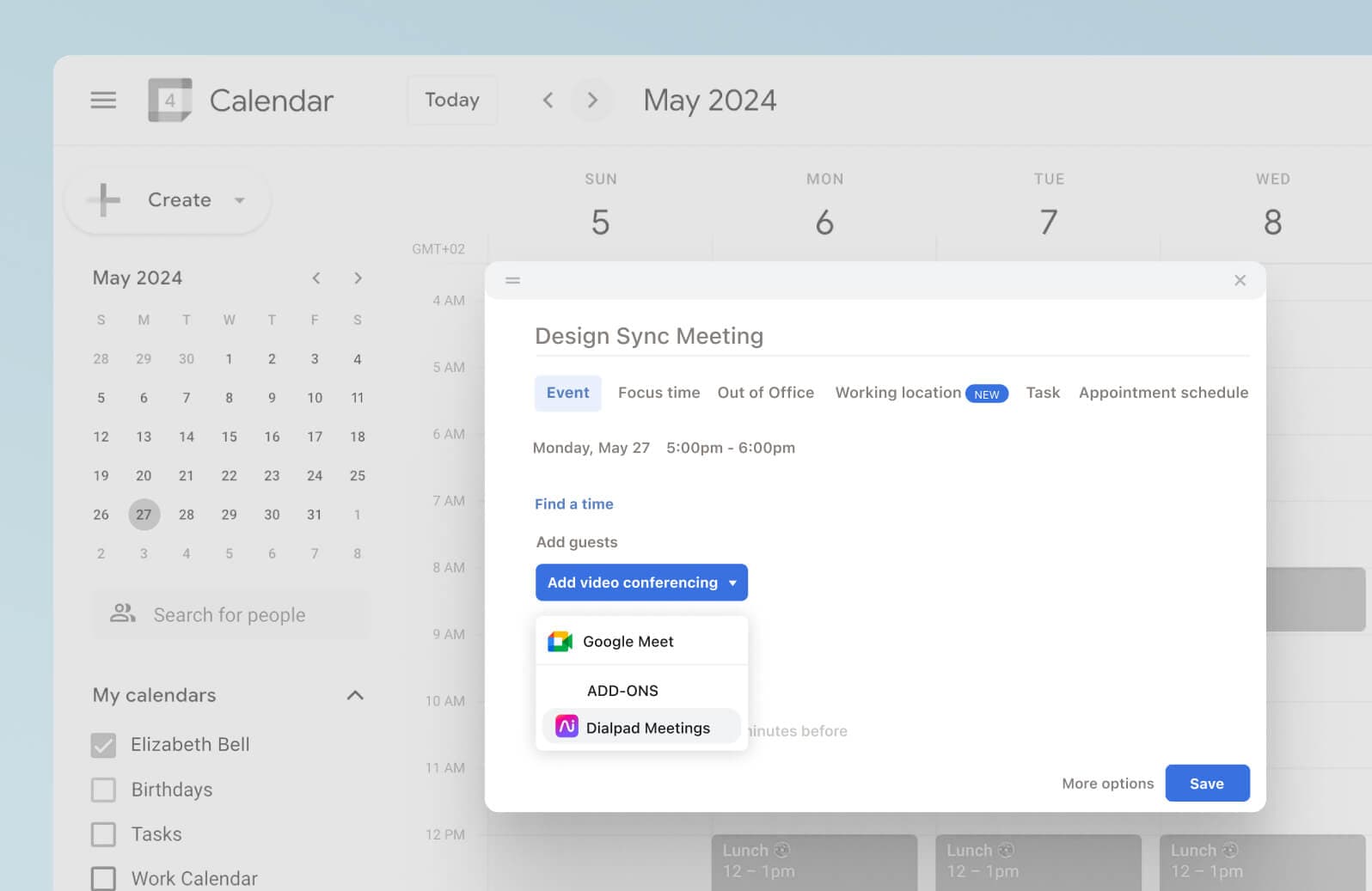
Bookings
The ultimate goal though, is getting that deal signed. If you’re managing AEs, this is one of the most critical metrics to measure sales performance.
4 Key sales efficiency metrics to track
So you know which activities to look at. But how successfully are reps executing on these? Tracking sales efficiency metrics helps you identify potential areas for improvement and keep an eye on where deals might be slipping. Here are a few examples of sales efficiency metrics to track:
Call-to-meeting ratio
The call-to-meeting ratio measures how effective your sales reps are at converting calls or emails into scheduled meetings. A higher ratio generally indicates efficient prospect engagement and a higher likelihood of successful deals.
Opportunity-to-close ratio
The opportunity-to-close ratio assesses the efficiency of your sales team in converting qualified opportunities into closed deals. A high ratio here means your sellers are strong closers and good at deal progression.
Time spent selling
This one is pretty self-explanatory—if you can maximize the amount of time your sales team spends actively selling and minimize non-selling activities (like logging calls), you’ll improve your overall sales efficiency.
Follow-up response time
Time is of the essence. Prospects are busy, and you have to take advantage of that brief window when you’re top of mind for them. That’s why the speed at which your sales team responds to leads and follows up on opportunities is a critical efficiency metric. Not only do faster response times accelerate your sales cycle, it also increases the likelihood of converting leads into customers because you’re striking while the iron is hot. (More on high velocity sales here.)
5 Important sales metrics for SaaS businesses to track
Software as a Service (SaaS) businesses have to track a few unique sales metrics that aren’t relevant to the average sales team, mainly because of the subscription-based nature of their business models. Here are some key sales metrics that are specific to SaaS businesses:
Monthly Recurring Revenue (MRR)
MRR is the predictable revenue generated from subscription-based services on a monthly basis. Tracking MRR helps SaaS businesses assess their financial health and runway, and predict future revenue streams.
Customer churn rate
Customer churn rate measures the percentage of customers who stop doing business with your company, or “churn out,” within a given period. A lower churn rate indicates higher customer retention and satisfaction. If you’re really good at retaining customers, you may even have a negative churn rate!
Customer Lifetime Value (CLV) to Customer Acquisition Cost (CAC) Ratio
The CLV to CAC ratio helps SaaS businesses evaluate the balance between the value a customer brings over their lifetime and the cost of acquiring that customer. A higher ratio generally means healthier profitability and that you’re acquiring customers sustainably.
Free trial conversion rate
For SaaS businesses on freemium models that offer free trials, the free trial conversion rate measures the percentage of trial users who convert to paying customers. You want as many prospects signing up for your free trial and trying out your product as possible, but the ultimate goal is to turn that into revenue, which is what this metric measures.
Average Revenue Per User (ARPU)
ARPU calculates the average revenue generated by each customer. SaaS businesses use this metric to identify high-value customers—you generally want a high ARPU because it means you won’t have to win as many new customers to hit your revenue targets.
How to measure sales performance metrics and glean actionable insights
Now, let’s look at a few concrete ways to measure these sales performance metrics, including how to collect and analyze the data.
1. Automate activity logging with a contact center or CRM system
When you’re getting reps to measure their sales activity metrics, try to automate this for them as much as possible to minimize human error (and/or laziness). When reps are making tens or hundreds of calls a day, you can’t realistically expect them to log each and every single call accurately. Even if they do do this, it’s not a good use of their time.
A good outbound contact center platform, like Dialpad Sell, can help with sales call reporting and integrate with CRMs like Salesforce and HubSpot to auto-log those activities right inside the CRM:
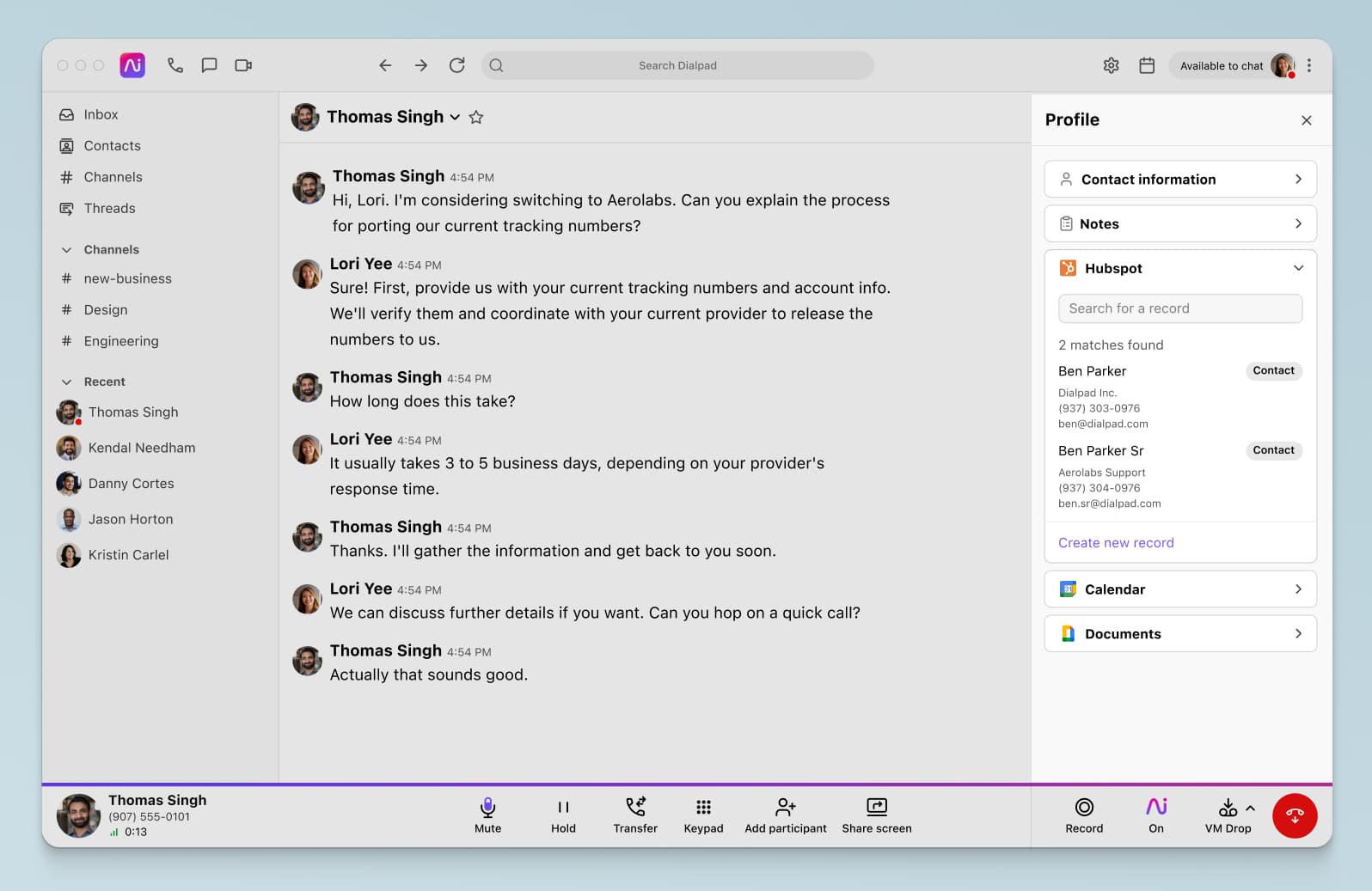
This centralizes your customer data and interactions, and provides a comprehensive view of your sellers’ activities, with minimal work on their end.
2. Don’t measure metrics like call volumes manually
Similarly, managers and coaches don’t need to manually pull outbound sales metrics or bookings numbers every week or every month. It’s time-consuming, prone to error, and not necessary.
Again, an outbound contact center solution like Dialpad would be able to show all of this data in a clean dashboard (how many calls did reps make? How many did they miss?):
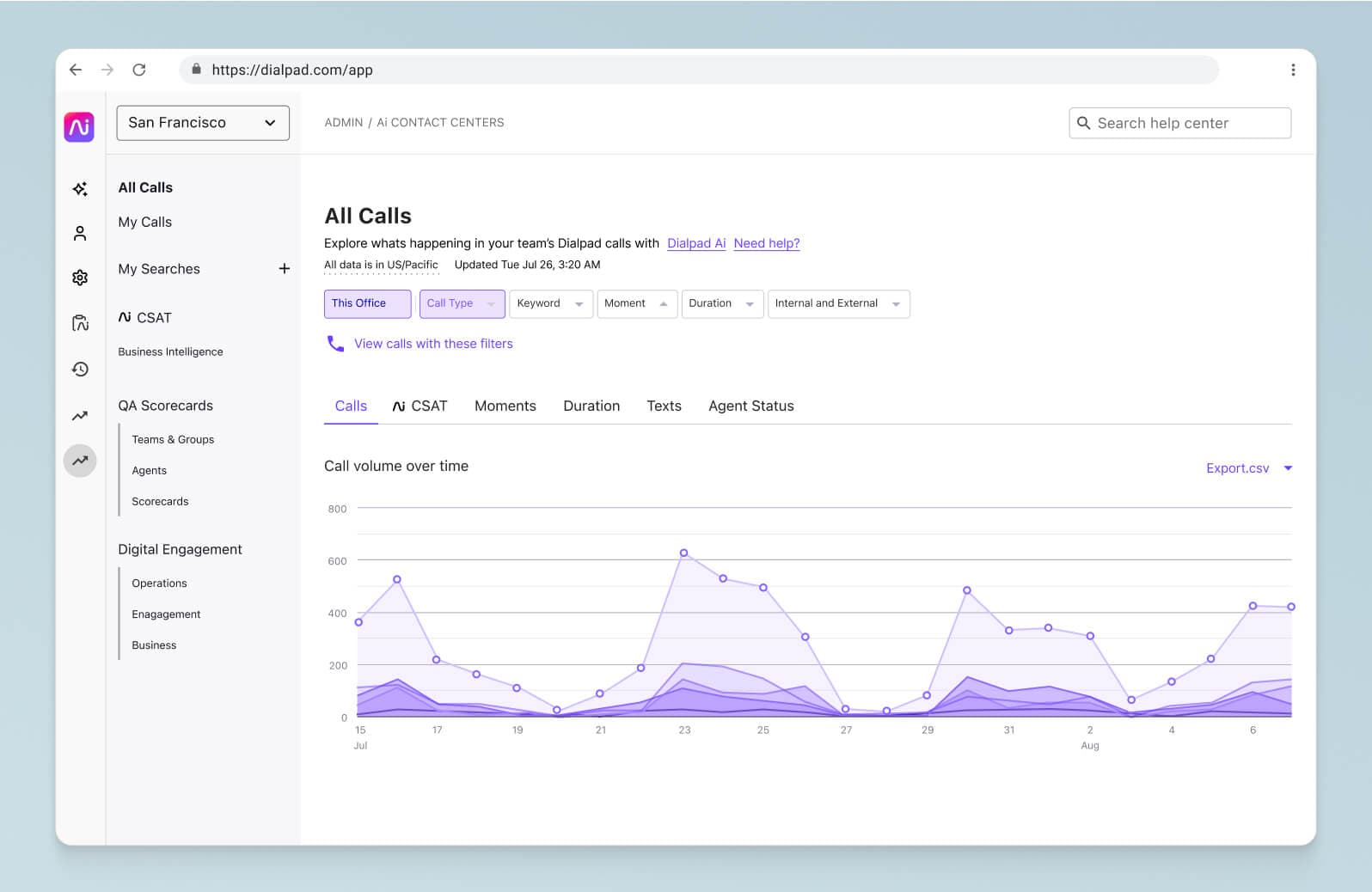
3. Use AI tools to help with QA
If your sales managers are strapped for time (like most sales managers), you could take QA (quality assurance) scoring off their plates using sales AI tools. We use Dialpad Sell’s Ai Scorecards functionality to analyze calls and suggest if reps completed the required tasks based on different sales methodologies—which can then inform their sales coaching strategy down the line:

We can see from our dashboard in Dialpad which teams and individuals are doing well based on calls graded, average grades, and how they’re trending over time:
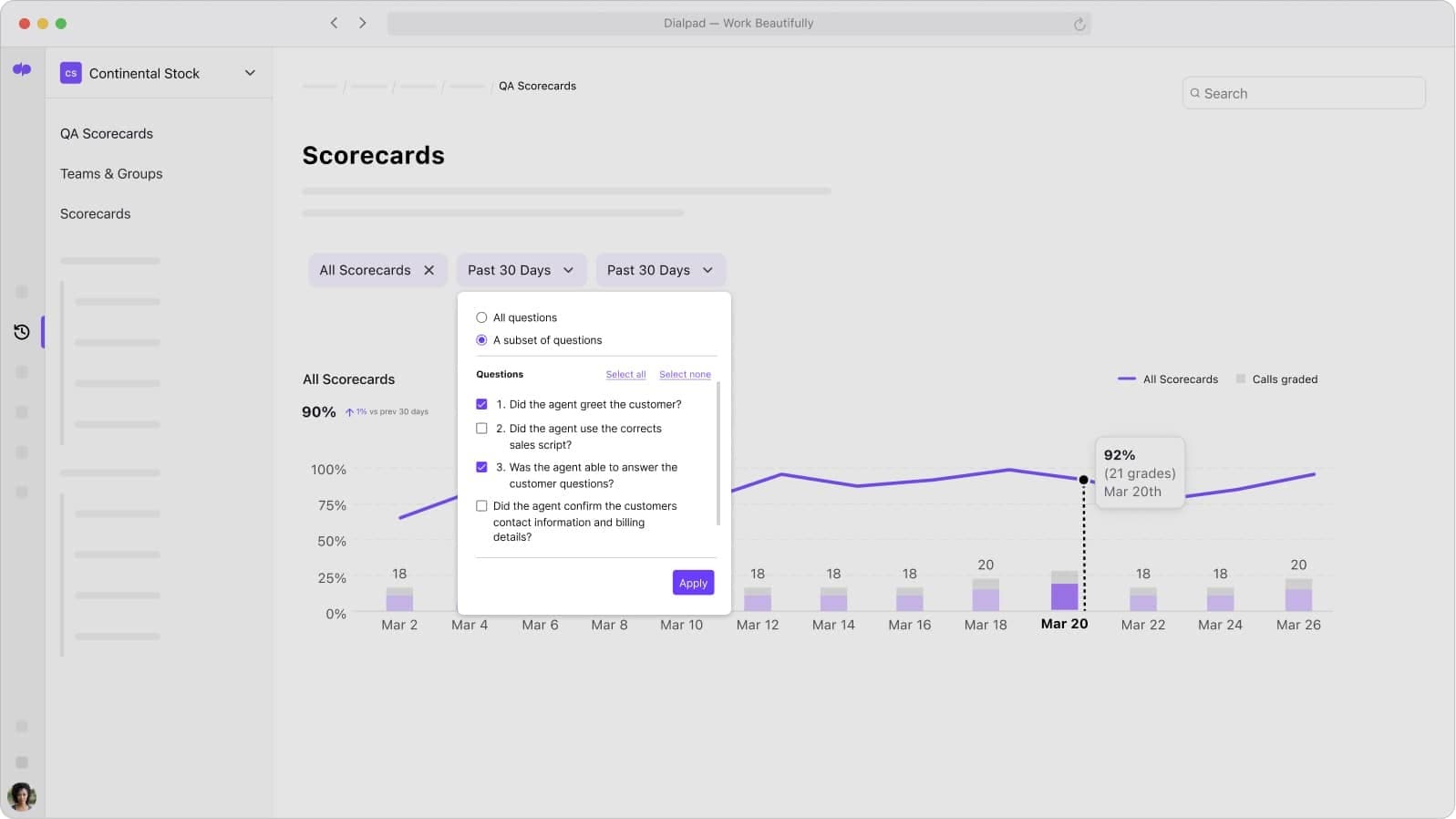
This means that instead of having to do QA for every call from scratch, managers and coaches can just step in and review the call recording or transcript if they want to verify if a score was correct. They can also customize our QA scorecard requirements based on their team’s needs.
4. Use the right tools to measure the specific metrics you need
One trap that some sales teams fall into is trying to over-index on “all-in-one” tools. While it’s smart to do this to a certain degree—you don’t want to be paying for 10 or 15 apps while only using three or four—there are way too many sales metrics to truly achieve this.
For example, if you want to look at win rate, you might need Anaplan or a similar solution, but if you want to measure CSAT, you would use something like Dialpad instead. (Sometimes, even if a certain piece of sales software claims to have a huge range of features, they’re often add-ons that aren’t developed as fully as their core features. Always get a product demo or sign up for the free trial to get a sense of whether these features are actually usable.)
5 Best practices for tracking sales metrics
Now that you’ve got a few ideas for how to measure sales metrics, here are a few best practices to keep in mind.
1. Always have clear objectives and KPIs
Start by clearly defining your team’s business objectives and the sales KPIs (key performance indicators) aligned with those goals. There are hundreds of possible KPIs out there, and not all of them will be relevant to your team. (Do you really want your SDRs to care about deal size at that stage, or should they just focus on getting as many prospects in the door as possible?) Make sure you’re focusing your sellers to the right metrics off the bat.
2. Align metrics with business goals
On a related note, it’s critical that the metrics you track directly align with your overall business goals. If your company has decided that this quarter, everyone really needs to focus on significantly increasing the average deal size—but your team is only focused on making more calls, this doesn’t really ensure that your sales efforts will contribute meaningfully to company-wide success.
3. Leverage technology and automation where you can
We’ve talked a lot about sales automation, but it’s hard to overstate how important it is. There’s more data available to us today than ever before, and it’s not possible for sales leaders to try to analyze and glean insights themselves because of the sheer volume of information out there.
Whether it’s using a call center solution that logs sales activities for your team, or using AI to uncover conversational insights from sales calls so that leaders don’t have to listen to each individual call from beginning to end, there’s a huge opportunity for revenue orgs and sales teams to be more data-driven, without getting bogged down by data:
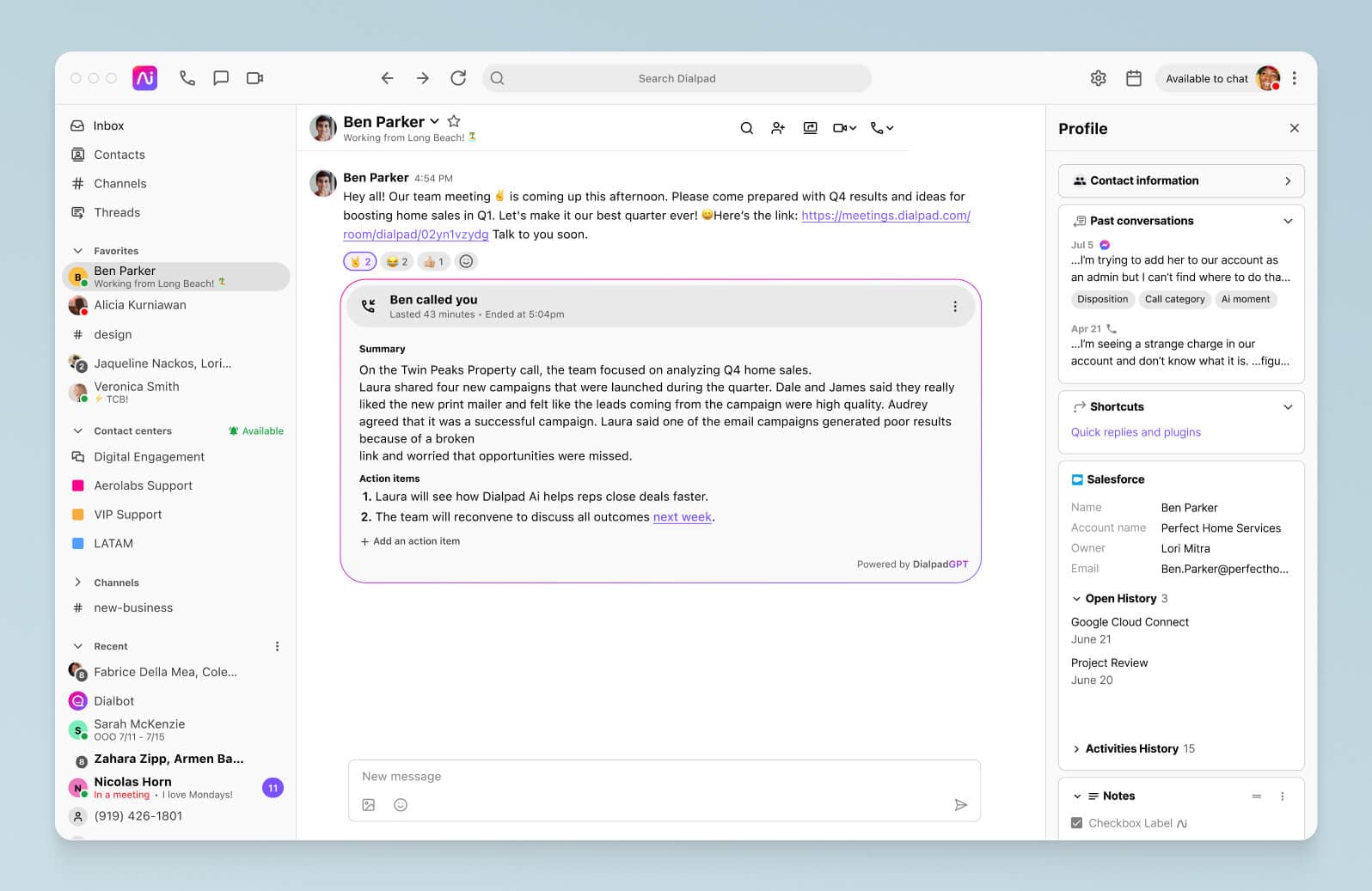
4. Review and analyze metrics regularly
Set a regular cadence for reviewing and analyzing sales metrics. Whether it's weekly, monthly, or quarterly, consistent reviews allow you to spot trends, assess performance, and coach sellers more effectively.
We have a weekly sales call where all regions and levels of sellers review our numbers (from enterprise sales metrics to SMB metrics) together, celebrate wins, and prepare for any upcoming campaigns with guest speakers from Marketing. It helps keep everyone on the same page and makes sure our key metrics are top of mind for everyone from enterprise AEs to new SDRs.
5. Benchmark your performance against industry standards
Benchmarking your sales metrics against industry standards provides a lot of valuable context and helps leaders identify areas where you excel and areas that may require improvement.
This can involve optimizing your sales tax collection and remittance processes to ensure compliance and avoid unnecessary penalties. Take a look at this Small Business HQ article to find out other ongoing compliance requirements to streamline your business operations and increase efficiency.
Numbers that might not look great initially may actually be typical for your industry—this information is crucial for setting realistic goals and expectations.
Which sales metrics are you tracking?
Every advantage you can give your sales team is valuable, and while most people think of sales battlecards and discount campaigns, having a clear sales metrics strategy can be a competitive advantage too.
By helping your sellers understand the range of important sales metrics for your business and follow best practices based on actionable insights, you can empower them to achieve sustainable success and hit their numbers reliably.
Track sales metrics like never before with Dialpad Sell
Book a demo for a personalized walkthrough of what Dialpad Sell can do for you. Or, take a self-guided interactive tour of the app first!








